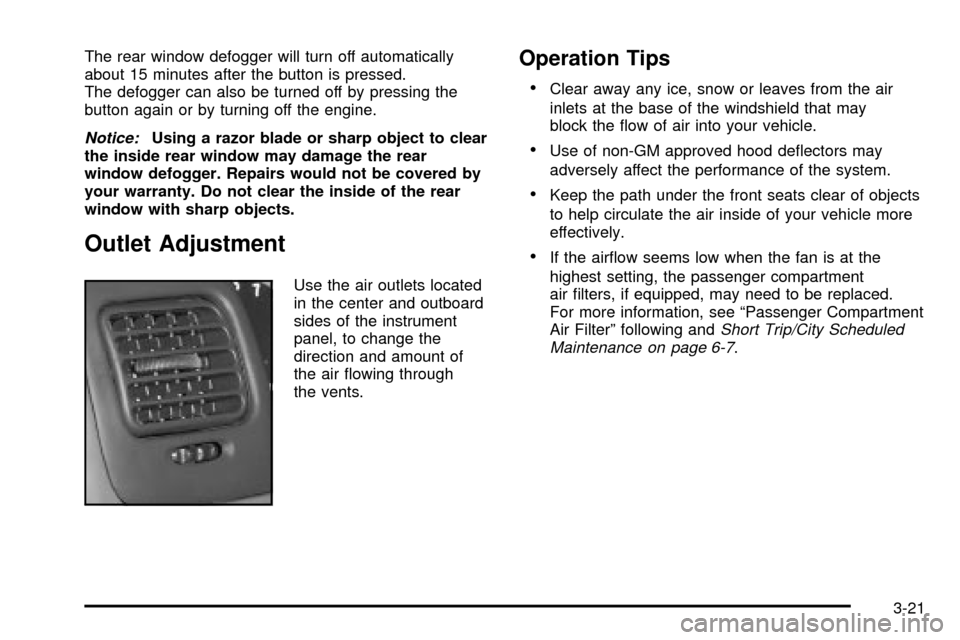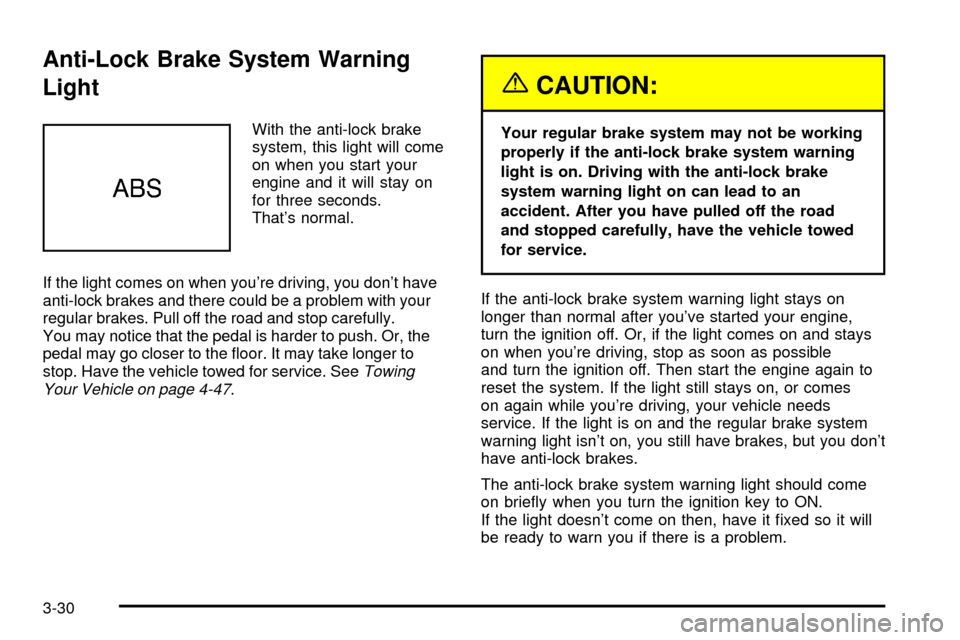engine CHEVROLET TRACKER 2003 2.G Owner's Manual
[x] Cancel search | Manufacturer: CHEVROLET, Model Year: 2003, Model line: TRACKER, Model: CHEVROLET TRACKER 2003 2.GPages: 372, PDF Size: 2.65 MB
Page 126 of 372

Automatic Headlamp System
Your vehicle is equipped with an automatic light sensor
on top of the instrument panel, on the passenger's
side of the vehicle, so be sure it is not covered. If it is,
the headlamps will remain on continuously.
There is a delay in the transition between the daytime
and nighttime operation of the DRL and the Automatic
Headlamp Systems so that driving under bridges or
bright overhead street lights does not affect the system.
The DRL and Automatic Headlamp Systems will only
be affected when the light sensor sees a change
in lighting lasting longer than this delay.
When it is dark enough outside, or you are driving
through a parking garage, heavy overcast weather
or a tunnel, the system will turn on your low-beam
headlamps at normal brightness. Along with your
vehicle's headlamps, the taillamps, sidemarker, parking
lamps and the instrument panel lights will also turn
on. The radio display will dim.
As with any vehicle, you should turn on the regular
headlamps when you need them.To temporarily disable your vehicle's DRL and Automatic
Headlamp Systems functions, do the following:
1. Before turning the ignition key to ON or START,
set the parking brake.
2. Then turn the ignition key to ON or START.
·The Automatic Headlamp System will not turn on
under any conditions, even in darkness.
·The DRL will not turn on.
The DRL and Automatic Headlamp System functions will
stay off with the ignition on, until you release the parking
brake. Once the parking brake is released the DRL will
turn on if it is daylight or the Automatic Headlamp System
will turn on if it is dark enough outside.
If you turn the ignition key to ON or START and then set
the parking brake, the DRL will turn off (in all conditions)
and the Automatic Headlamp System will remain on
(if dark enough outside). Any other uses of the parking
brake after the engine is turned on will have no effect on
the normal Automatic Headlamp System operation.
Headlamps On Reminder
If you turn the ignition off, remove the key, open the
door and leave the lamps on, a tone will remind you to
turn off your lamps.
3-14
Page 131 of 372

:(Outside Air):Slide the lower right lever to the
right for outside air. With the lever in this position,
outside air will circulate throughout your vehicle.
?(Recirculation):Slide the lower right lever to the
left for recirculated air. With the lever in this position
outside air and odors can be prevented from entering
your vehicle and also helps heat or cool the air
inside your vehicle more quickly.
If the lever is in the middle of the two positions, you will
have both outside and recirculated air inside your
vehicle.
If you are in city traffic, your vehicle is stopped and
idling or the weather is hot, the system may be switched
from the outside air mode to the recirculation mode.
To help prevent the air inside of your vehicle from
becoming too stale, be sure to return to outside air
periodically.
Temperature Control:Slide the lever located on the
lower left side to change the temperature. Move it to
the right for warmer air and to the left for cooler
air. Without air conditioning, the air temperature cannot
be less than the outside air temperature.Air Conditioning (A/C):Press the air conditioning
(A/C) button to turn the air-conditioning system on or off.
When A/C is pressed, an indicator light in the button
will come on to let you know that the air conditioning is
activated.
On hot days, open the windows to let hot inside air
escape; then close them. This helps to reduce the time
it takes for your vehicle to cool down. It also helps
the system to operate more efficiently.
For quick cool down on hot days:
1. Select the vent mode.
2. Select the recirculation mode.
3. Select A/C.
4. Select the coolest temperature.
5. Select the highest fan speed.
The air-conditioning system removes moisture from the
air, so you may sometimes notice a small amount of
water dripping underneath your vehicle while idling
or after turning off the engine. This is normal.
3-19
Page 133 of 372

The rear window defogger will turn off automatically
about 15 minutes after the button is pressed.
The defogger can also be turned off by pressing the
button again or by turning off the engine.
Notice:Using a razor blade or sharp object to clear
the inside rear window may damage the rear
window defogger. Repairs would not be covered by
your warranty. Do not clear the inside of the rear
window with sharp objects.
Outlet Adjustment
Use the air outlets located
in the center and outboard
sides of the instrument
panel, to change the
direction and amount of
the air ¯owing through
the vents.
Operation Tips
·Clear away any ice, snow or leaves from the air
inlets at the base of the windshield that may
block the ¯ow of air into your vehicle.
·Use of non-GM approved hood de¯ectors may
adversely affect the performance of the system.
·Keep the path under the front seats clear of objects
to help circulate the air inside of your vehicle more
effectively.
·If the air¯ow seems low when the fan is at the
highest setting, the passenger compartment
air ®lters, if equipped, may need to be replaced.
For more information, see ªPassenger Compartment
Air Filterº following and
Short Trip/City Scheduled
Maintenance on page 6-7.
3-21
Page 136 of 372

Warning Lights, Gages and
Indicators
This part describes the warning lights and gages that
may be on your vehicle. The pictures will help you
locate them.
Warning lights and gages can signal that something is
wrong before it becomes serious enough to cause
an expensive repair or replacement. Paying attention
to your warning lights and gages could also save you or
others from injury.
Warning lights come on when there may be or is a
problem with one of your vehicle's functions. As you
will see in the details on the next few pages, some
warning lights come on brie¯y when you start the engine
just to let you know they're working. If you are familiar
with this section, you should not be alarmed when
this happens.Gages can indicate when there may be or is a problem
with one of your vehicle's functions. Often gages
and warning lights work together to let you know when
there's a problem with your vehicle.
When one of the warning lights comes on and stays on
when you are driving, or when one of the gages
shows there may be a problem, check the section
that tells you what to do about it. Please follow this
manual's advice. Waiting to do repairs can be
costly ± and even dangerous. So please get to know
your warning lights and gages. They're a big help.
3-24
Page 138 of 372

Speedometer and Odometer
Your speedometer lets you see your speed in both
miles per hour (mph) and kilometers per hour (km/h).
Your odometer shows how far your vehicle has
been driven, in either miles (used in the United States)
or kilometers (used in Canada).
Your vehicle's odometer is tamper-resistant.
You may wonder what happens if your vehicle needs a
new odometer installed. The new one is set at zero.
Then a label is attached on the driver's door to show
the old reading and when the new one was installed.
Trip Odometer
The trip odometer can tell you how far your vehicle has
been driven since you last set the trip odometer to
zero. The button located to the right of the odometer
display allows you to switch between the odometer
and the two trip odometers. Press the button once to
switch to TRIP A and again to switch to TRIP B.
To return the display to the odometer reading,
press the trip odometer button again.
To set the trip odometers to zero, press and hold
the button.
Tachometer
The tachometer shows engine speed in thousands of
revolutions per minute (rpm). You can use it while
driving to select correct shift points. The tachometer
may not return to zero when the engine is not running.
Notice:If you operate the engine with the
tachometer in the shaded warning area, your vehicle
could be damaged, and the damages would not
be covered by your warranty. Do not operate
the engine with the tachometer in the shaded
warning area.
Safety Belt Reminder Light
When the key is turned to ON or START, a tone will
come on for several seconds to remind people to fasten
their safety belts, unless the driver's safety belt is
already buckled.
The safety belt light will
also come on and stay on
until the driver's belt is
buckled.
3-26
Page 140 of 372

Charging System Light
This light will come on
brie¯y when you turn on the
ignition, but the engine is
not running, as a check to
show you it is working.
Then it should go out when
the engine starts.
If the light stays on or comes on while you are driving,
you may have a problem with the electrical charging
system. It could indicate that you have an electrical
problem. Have it checked right away. Driving while this
light is on could drain your battery.
If you must drive a short distance with this light on, be
certain to turn off all your accessories, such as the radio
and air conditioner.
Brake System Warning Light
When the ignition is on, the brake system warning light
will come on when you set your parking brake. The
light will stay on if your parking brake doesn't release
fully. If it stays on after your parking brake is fully
released, it means you have a brake problem.
Your vehicle's hydraulic brake system is divided into two
parts. If one part isn't working, the other part can still
work and stop you. For good braking, though, you need
both parts working well.
If the warning light comes on, there could be a brake
problem. Have your brake system inspected right away.
3-28
Page 142 of 372

Anti-Lock Brake System Warning
Light
With the anti-lock brake
system, this light will come
on when you start your
engine and it will stay on
for three seconds.
That's normal.
If the light comes on when you're driving, you don't have
anti-lock brakes and there could be a problem with your
regular brakes. Pull off the road and stop carefully.
You may notice that the pedal is harder to push. Or, the
pedal may go closer to the ¯oor. It may take longer to
stop. Have the vehicle towed for service. See
Towing
Your Vehicle on page 4-47.
{CAUTION:
Your regular brake system may not be working
properly if the anti-lock brake system warning
light is on. Driving with the anti-lock brake
system warning light on can lead to an
accident. After you have pulled off the road
and stopped carefully, have the vehicle towed
for service.
If the anti-lock brake system warning light stays on
longer than normal after you've started your engine,
turn the ignition off. Or, if the light comes on and stays
on when you're driving, stop as soon as possible
and turn the ignition off. Then start the engine again to
reset the system. If the light still stays on, or comes
on again while you're driving, your vehicle needs
service. If the light is on and the regular brake system
warning light isn't on, you still have brakes, but you don't
have anti-lock brakes.
The anti-lock brake system warning light should come
on brie¯y when you turn the ignition key to ON.
If the light doesn't come on then, have it ®xed so it will
be ready to warn you if there is a problem.
3-30
Page 143 of 372

Engine Coolant Temperature Gage
This gage shows the
engine coolant
temperature. If the gage
pointer moves to the
H (red) side, your engine
is too hot.
It means that your engine coolant has overheated and
you should stop your vehicle and turn off the engine
as soon as possible.
See
Engine Overheating on page 5-31.
Malfunction Indicator Lamp
Service Engine Soon Light
Your vehicle is equipped
with a computer which
monitors operation of the
fuel, ignition and emission
control systems.
This system is called OBD II (On-Board Diagnostics-
Second Generation) and is intended to assure that
emissions are at acceptable levels for the life of
the vehicle, helping to produce a cleaner environment.
The SERVICE ENGINE SOON light comes on to
indicate that there is a problem and service is required.
Malfunctions often will be indicated by the system
before any problem is apparent. This may prevent more
serious damage to your vehicle. This system is also
designed to assist your service technician in correctly
diagnosing any malfunction.
Notice:If you keep driving your vehicle with this
light on, after a while, your emission controls
may not work as well, your fuel economy may not
be as good and your engine may not run as
smoothly. This could lead to costly repairs that
may not be covered by your warranty.
3-31
Page 144 of 372

Notice:Modi®cations made to the engine,
transmission, exhaust, intake or fuel system of your
vehicle or the replacement of the original tires
with other than those of the same Tire Performance
Criteria (TPC) can affect your vehicle's emission
controls and may cause this light to come on.
Modi®cations to these systems could lead to costly
repairs not covered by your warranty. This may
also result in a failure to pass a required Emission
Inspection/Maintenance test.
This light should come on, as a check to show you it is
working, when the ignition is on and the engine is
not running. If the light does not come on, have it
repaired. This light will also come on during a
malfunction in one of two ways:
·Light FlashingÐ A mis®re condition has been
detected. A mis®re increases vehicle emissions
and may damage the emission control system on
your vehicle. Diagnosis and service may be
required.
·Light On SteadyÐ An emission control system
malfunction has been detected on your vehicle.
Diagnosis and service may be required.
If the Light Is Flashing
The following may prevent more serious damage to
your vehicle:
·Reducing vehicle speed.
·Avoiding hard accelerations.
·Avoiding steep uphill grades.
·If you are towing a trailer, reduce the amount of
cargo being hauled as soon as it is possible.
If the light stops ¯ashing and remains on steady,
see ªIf the Light Is On Steadyº following.
If the light continues to ¯ash, when it is safe to do so,
stop the vehicle.Find a safe place to park your vehicle.
Turn the key off, wait at least 10 seconds and restart
the engine. If the light remains on steady, see ªIf the
Light Is On Steadyº following. If the light is still ¯ashing,
follow the previous steps, and see your dealer for
service as soon as possible.
3-32
Page 145 of 372

If the Light Is On Steady
You may be able to correct the emission system
malfunction by considering the following:
Did you recently put fuel into your vehicle?
If so, reinstall the fuel cap, making sure to fully install
the cap. See
Filling Your Tank on page 5-6. The
diagnostic system can determine if the fuel cap has
been left off or improperly installed. A loose or missing
fuel cap will allow fuel to evaporate into the atmosphere.
A few driving trips with the cap properly installed
should turn the light off.
Did you just drive through a deep puddle of water?
If so, your electrical system may be wet. The condition
will usually be corrected when the electrical system
dries out. A few driving trips should turn the light off.Have you recently changed brands of fuel?
If so, be sure to fuel your vehicle with quality fuel.
See
Gasoline Octane on page 5-4. Poor fuel quality will
cause your engine not to run as efficiently as designed.
You may notice this as stalling after start-up, stalling
when you put the vehicle into gear, mis®ring, hesitation
on acceleration or stumbling on acceleration.
(These conditions may go away once the engine is
warmed up.) This will be detected by the system and
cause the light to turn on.
If you experience one or more of these conditions,
change the fuel brand you use. It will require at least
one full tank of the proper fuel to turn the light off.
If none of the above steps have made the light turn off,
your dealer can check the vehicle. Your dealer has the
proper test equipment and diagnostic tools to ®x any
mechanical or electrical problems that may have
developed.
3-33